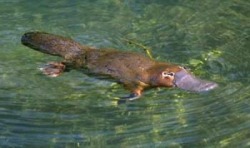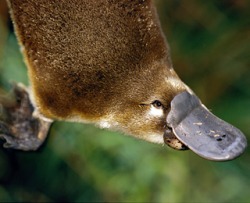Adaptation
The Duck-billed Platypus
As I said earlier, I will be having two examples of animals that have adapted to their habitats throughout the ages. For example number one, I will be talking about the rather odd Duck-billed Platypus. This strange creature has short brown fur and a dense undercoat to keep it warm when it's swimming and underwater. It doesn't start fights unless threatened, but even so, it has sharp claws on it's toes to attack with should it be attacked. All Platypuses have spurs on the back of their back feet, but only the males are venomous. They live in burrows on riverbanks and by water, therefore, their eggs are stuck together so that they can not roll off. It has a flat, beaver-like tail to help it steer and swim through the water. The platypuses have tiny ears that can be closed underwater when needed. They are known to be very shy creatures. The platypuses are most active from dusk to dawn. They have adapted well to their environment, seeing the poisonous spurs, their eggs and that their ears can be closed underwater.
They are far down on the extinction list and are the least concerned for going extinct. After I have explained all of this, some of you might be wondering "What exactly does this thing look like?". Below are some pictures of this strange, but wonderful animal.
They are far down on the extinction list and are the least concerned for going extinct. After I have explained all of this, some of you might be wondering "What exactly does this thing look like?". Below are some pictures of this strange, but wonderful animal.
http://www.youtube.com/watch?v=OVneqhu9oZk
(Sorry, once again, I couldn't get the video to upload to the site.)
(Sorry, once again, I couldn't get the video to upload to the site.)
You're probably thinking "Whoa, that thing is ugly!" or something along those lines. But remember, just because something is different, doesn't mean it's bad. Now, let's continue on to my list of adapted animals!


